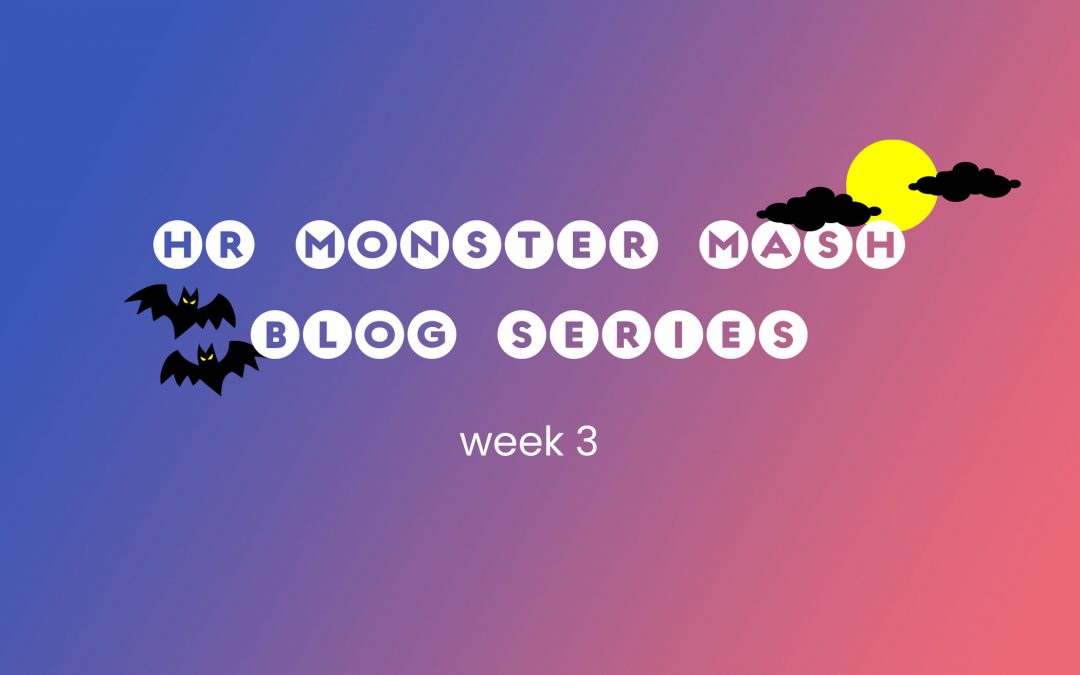
HR Monster Mash: Week 4
Last week we highlighted a cast of characters in the Witches and Warlocks category who cast their spells on the workplace, creating a toxic work culture.
This week let’s take a look at the flip side of a toxic work culture— horrible bosses, AKA Trolls!
 Trolls are horrible bosses who make you want to scream with their bullying, micromanaging or up-and-down, rage-like behaviors. The troll boss may hog the credit for your achievements, throw you under the bus or show a total disregard for your wellbeing.
Trolls are horrible bosses who make you want to scream with their bullying, micromanaging or up-and-down, rage-like behaviors. The troll boss may hog the credit for your achievements, throw you under the bus or show a total disregard for your wellbeing.
The Devil – Or in this case “The Devil Wears Prada”. Who could forget Miranda Priestly, portrayed by the talented Meryl Streep in the film? Just thinking about that icy stare sends shivers down my spine. Her character is ruthless, manipulative, and unnecessarily cruel. She regularly demands impossible tasks from her employees, like scheduling a flight out of Miami during a major hurricane or getting a copy of an unpublished Harry Potter book, just so her daughters can read it before the release date. She imposes upon her employees at insane hours with no regard for their personal lives. The absurdity makes it comical, but there is nothing comical about being bullied in real life. We’ve all either encountered or witnessed bullying in our lifetime. A study by Workplace Bullying Institute, showed that 19% of American workers reported being bullied or having previously been bullied at work, with another 19% who reported witnessing it. Bullying can be psychologically and emotionally damaging and can be very difficult to overcome.
The Micromanager – I think most of us have seen the memes of Gary Cole playing Bill Lumbergh in the movie, Office Space. This cult classic has generated inspiration for countless memes on social media, including the most famous, “If you could go ahead and do that, it’d be GREAT!”. And while Bill models several troll boss traits, he is the consummate nitpicker and is constantly focused on trivial matters such as report covers instead of spending time on more important issues. He spends most of his day hovering over his staff and well…micromanaging, right down to the enforcement of Hawaiian shirt day.
Micromanagement is a sign of weak leadership. What are the signs? A micromanager is constantly asking for updates and is more likely to revise your work than provide feedback on how it could be improved thus providing a development opportunity. You are not allowed to make even small decisions, and because this type manager is quick to find fault, in even the smallest of details, projects are likely to be delayed and stress increases well beyond normal levels, sometimes even to the point of causing physical harm.
A study performed by Trinity Solutions showed that 70% of people polled considered quitting their jobs and 30% did quit because of being micromanaged.
The most ironic thing about micromanagers is that they often believe their oversight is a measure necessary to achieve excellence. However, the time spent helicoptering over their employees is likely exactly what is keeping them from effectively managing their department.
The Brilliant Jerk – It almost sounds like an oxymoron. There was certainly nothing moronic about Gregory House in the TV Series titled, House MD. The Huffington Post referred to his character as the “Sherlock Holmes” of medicine. But unlike Holmes, House goes out of his way to be rude, shirk responsibilities that he feels are beneath him, and thinks the hospital policies are “suggested guidelines”. There is no question he’s a genius when it comes to the practice of medicine, but what is the cost of keeping someone like House around in the real world?
We’ve all worked with a gifted high performer who was an undeniable jerk. To put it simply, they don’t play well with others. Historically, this type of toxic boss tends to get a free pass when it comes to being rude or abrasive as long as they are delivering results. However, new studies have shown, there is a high cost to tolerating or even rewarding the brilliant jerk.
They can tear an organization apart from the inside out. They introduce toxicity into organizational culture that reduces moral and increases team turnover. In the long term, this toxicity will erode even the best of strategies.
The Work Institute estimated that 77% of turnover could have been prevented by employers. And that turnover on average it costs 1/3 of an employee’s annual salary, and 1 to 1.5 times the annual salary for high tech jobs.
The Rage-aholic – I can think of no better example of a Rage-aholic boss, than Gordon Ramsay, Celebrity Chef. He has been wildly successful with his cooking themed shows like Hell’s Kitchen, Kitchen Nightmares, Master Chef, Hotel Hell, and 24 Hours to Hell and Back – just to name a few. Viewers can hardly wait to tune in to each episode to see Ramsay scream in the faces of incompetent chefs, struggling and sometimes delusional restaurant owners, or even difficult customers. He is not swayed by gender, looks, or social status. He is an equal opportunist when it comes to raging.
Whether it’s scallops sticking to the pan, undercooked lamb, or unsanitary food handling, Ramsay is notoriously abrasive and ready with a robust collection of swear words and devastating insults. With his bullish belittling, he leaves behind a broad wake of dumbfounded and tearful, kitchen staff.
When we see characters like our troll bosses on TV or in the movies, we laugh. In real life having a toxic boss can take its toll. You may dream of telling your boss to go jump in a lake? But they’d probably just delegate it to you, micromanage it, and then take credit for the awesome splash!
It’s important to know when to stand up to your boss and equally important to be professional in your approach. You’ll want to think through any possible repercussions to ensure the truth doesn’t set you free from your job. Be specific, be confident, and recognize that you cannot control the response, but you can get outside help. If the behavior is extreme or unlawful you should immediately seek help from your HR department. You may not the only person being impacted by the boss’ behavior. No one should feel unsafe, disrespected, or unappreciated at work. Speaking with HR will give the organization an opportunity to protect you and your peers from suffering a toxic work culture due to a troll boss.
We’ve shown a lot of examples of troll bosses, using fictional characters that people can easily relate to, so using that same theme, who is our favorite “Best” TV boss?
As a longtime fan of NCIS, the honor goes to Leroy Jethro Gibbs, who is head of the NCIS Major Case Response team. He is a strong leader who will take the heat for his team and frequently shows a caring side. He does all the right things you would expect of a great boss. He offers clear direction, gives stretch projects, trusts his team to get the job done without micromanagement and has a good sense of humor. He goes out of his way to makes thoughtful gestures to his staff, like keeping Abby well stocked in Caf Pow, her favorite high energy caffeinated drink. He also provides positive feedback when the team achieves measures of success. You can see how meaningful it is by the pride beaming from Tony’s face when Gibbs says, “Good job DiNozzo!”
He empowers his team to be independent thinkers instead of micromanaging. He expects them to find their own solutions and trusts they will get the job done. Throughout the series many of the team have been offered external opportunities. But the loyalty that comes from strong leadership and culture drives top talent retention.


 Welcome back to Week 3 of the HR Monster Mash!
Welcome back to Week 3 of the HR Monster Mash!
 Welcome back to Week 2 of our Halloween Monster Mash Blog Series! This week we are talking about the Ghost, and Frankenstein! Spoooookyyyy!
Welcome back to Week 2 of our Halloween Monster Mash Blog Series! This week we are talking about the Ghost, and Frankenstein! Spoooookyyyy! The Frankenstein – a group of HR systems that have been ineffectively pieced together resulting in inefficient business processes or data integrity issues.
The Frankenstein – a group of HR systems that have been ineffectively pieced together resulting in inefficient business processes or data integrity issues.
 The Skeleton
The Skeleton The Vampire – Inefficient business processes that suck the life out of you
The Vampire – Inefficient business processes that suck the life out of you